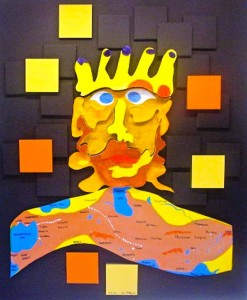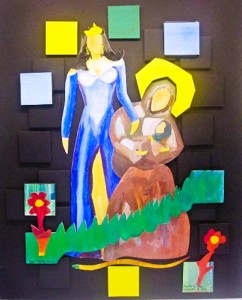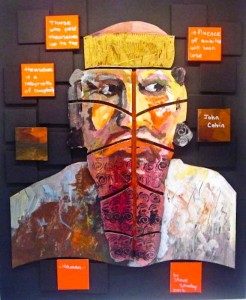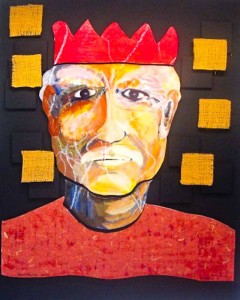The Esther Paintings
Introduction
Beginning in 1886 French archeologist explored the royal Persian city of Susa which is now located in Northern Iran. They excavated the ruins of the winter palace that was built by Darius the Great. The Book of Esther took place in that palace. On the walls of the palace they discovered ancient stone relief sculptures which now hang in the Louvre in Paris. I decided to borrow the idea of a relief sculpture when I painted the four main characters from the book. My mixed media composition used black form core, paper collage, and acrylic paint all glued on 16 x 20 inch plywood to mimic a three dimensional relief sculpture.
Xerxes
 He became King of Persia at the age of 36. He ruled twenty years before he and his son were assassinated by their body guard. His empire stretched from Egypt to India. Greek historians remember him as a rather cruel leader who lost a disastrous war against the Greeks and built the royal city of Persepolis. The Bible depicts him as shallow, impetuous, and out of touch with the day to day events taking place in his empire. He loved drinking parties and failed to take responsibility for the decisions made by his subordinates on his behalf. He surrounded himself with a group of advisers whose main purpose in life was to tell him what he wanted to hear.
He became King of Persia at the age of 36. He ruled twenty years before he and his son were assassinated by their body guard. His empire stretched from Egypt to India. Greek historians remember him as a rather cruel leader who lost a disastrous war against the Greeks and built the royal city of Persepolis. The Bible depicts him as shallow, impetuous, and out of touch with the day to day events taking place in his empire. He loved drinking parties and failed to take responsibility for the decisions made by his subordinates on his behalf. He surrounded himself with a group of advisers whose main purpose in life was to tell him what he wanted to hear.
There is also something sad about him. He was the product of a royal breeding system. For political purposes history says he married a queen he did not like which may be why he sought pleasure in his harem of beautiful women. He lost an unwinnable war with the Greeks that was started by his father. He was surrounded by enemies who eventually killed him.
I drew his face using a single line. The map of his empire is on his chest. The longer he lived in my studio, the more empathy I felt for him.
Esther
 Her parents died when she was young and she was adopted by her uncle Mordecai and raised in the winter capitol of Susa. She was part of the Jewish minority in the empire. She was taught to know her place and minimize her ethnic identity. But from a young age she also heard the stories of her people. She knew their God and revered him even though it was dangerous to speak his name.
Her parents died when she was young and she was adopted by her uncle Mordecai and raised in the winter capitol of Susa. She was part of the Jewish minority in the empire. She was taught to know her place and minimize her ethnic identity. But from a young age she also heard the stories of her people. She knew their God and revered him even though it was dangerous to speak his name.
As a beautiful young woman in her early twenties, she was taken captive by the king’s officials and held in his harem to be used as a well cared for sex slave. Her role was to provide pleasure for the king and children for the royal household. She somehow found a way to adapt and make the best of her situation. Later when crisis came, she rose to the occasion to fulfill a destiny far beyond what she might have imagined.
I painted Esther during Advent and I was struck with the similarities between Mary and Esther. Both women began their story as virgins; both were invited to offer up their bodies in service to the Lord; both exercised faith in the face of great risk; both of their lives were affected by a capricious king, both became widows; both did something that led to the salvation of her people; both become queens. In addition there is a historic connection of both women to Eve whose off-spring would crush Satan’s head. So I painted Esther (based on Miss Argentina 2010) standing next to Mary with the baby Jesus. Across their legs is a banner of shrubbery signifying Eve’s garden. At their feet slithers the snake.
Haman
 The king appointed Haman as Prime Minister responsible for running the day to day affairs of the kingdom. We don’t know why or how he got the job but we can assume it was partly because he was effective—he got things done using any means possible. Along the way he earned a few enemies which is probably why the king had to order Haman’s subordinates to bow to him each day. Haman, was part of a minority group with a long bitter struggle with the Jews. He drafted the edict to exterminate all of them in the empire
The king appointed Haman as Prime Minister responsible for running the day to day affairs of the kingdom. We don’t know why or how he got the job but we can assume it was partly because he was effective—he got things done using any means possible. Along the way he earned a few enemies which is probably why the king had to order Haman’s subordinates to bow to him each day. Haman, was part of a minority group with a long bitter struggle with the Jews. He drafted the edict to exterminate all of them in the empire
His life was based upon his accomplishments, his wealth, the number of his sons, and the honor he received from the king. Those are all external validations that mask an internal poverty of spirit. He was the tragic person that we might pity were it not for his deeds that were so evil. He had an insatiable longing for affirmation but no one of importance would give it to him.
I painted Haman’s face and beard in the style of Persian royal officials of his day. I wanted to show that his pursuit of fame and power was the result of something hidden at a deeper level of his soul. I also wanted to show that because he was not in touch with those hidden forces, he was falling apart psychologically and morally. Before I painted his face, I found newspaper clippings about current dictators along with current symbols of success and I pasted those items onto the paper. After I painted his face, I then cut it into puzzle pieces to show his fragmentation. The pieces are glued over an orange shadow of his face with the words from the Book of Esther describing him.
Mordecai
 Mordecai’s ancestors were initially taken into exile by the Babylonians. Generations of his Jewish tribe found a way to survive and even prosper. He was given positions of responsibility in the king’s government. He sat at the city gate where public policy was debated and business transactions were resolved.
Mordecai’s ancestors were initially taken into exile by the Babylonians. Generations of his Jewish tribe found a way to survive and even prosper. He was given positions of responsibility in the king’s government. He sat at the city gate where public policy was debated and business transactions were resolved.
He had a reputation for being loyal not only to the king but also to Yahweh and his people.
When Haman was elevated above all the other royal advisors to the position of prime minister, Mordecai refused to bow down to him. Why? It may have been that Mordecai had been a witness to Haman’s ruthless rise to fame making him unworthy of honor. It may have been that to honor Haman would result in dishonoring the king and his best interests. Or Haman may have had previous treacherous dealings with the Jews and to honor him would have resulted in Mordecai breaking solidarity with God’s people. Whatever the reason, Mordecai refused to bow down to Haman. It was a principled discernment that seemed to be made in consultation with the Lord.
I wanted to present Mordecai as a strong person who could stand for what was right in the midst of a godless and corrupt political environment. I tried to create a solid but compassionate face. He wears a crown to signify his promotion to Prime Minister at the end of the story. He also wears a shirt made to look like sack cloth to show his reliance on the Lord in the face of suffering. Hidden underneath the shirt are painted the words—Faith, Hope, Love.
Yahweh
The Book of Esther is the only book of the Bible where God’s name is not mentioned. But He is there. His invisible presence is seen through the fidelity of his people and their prayers to him. It is seen in favor being shown to Esther and Mordecai who work hard to do the right thing not only for the Jews but for all people. It is seen in the troubled mind of the chief antagonist, Haman, who sought to gain the whole world and in the process lost his soul.
To suggest that God is present but hidden in the shadows, I mounted each painting on black foam core.
